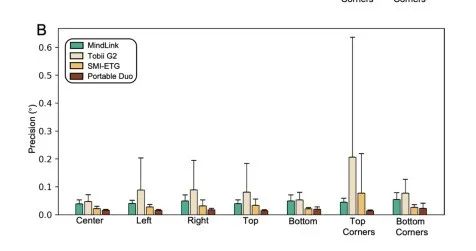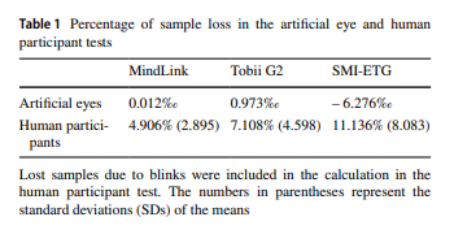

Part.1
introductory
![]()
![]()
![]()
![]()
![]()
![]()
![]()
![]()
Currently, most commercial devices for eye-tracking, by relying on cameras and image processing algorithms to track the gaze of the human eye, have been widely used in various fields such as psychology, neuroscience, linguistics, human factors, marketing, and human-computer interaction (Choi et al., 2017; Duchowski, 2002; Rosch & Vogel-Walcutt, 2013; Scott et al. 2019; Tien et al. 2014). However, the addition of emerging technologies can help optimize existing eye-tracking techniques and make high-speed, camera-free eye-tracking possible.
Eye-tracking glasses based on microelectromechanical systems (MEMS) sensors are characterized by their small size, low power consumption, ability to track high-speed eye movements and high quality data output. However, although the sampling rate of these glasses is very high, their eye-tracking solutions are mainly in the laboratory stage and lack of corresponding application cases.AdHawk's recently released Mindlink eye-tracking glasses offer the possibility of market application for this type of product.
MindLink eye tracking glasses use MEMS scanning and photodiodes to track eye movements. The scanner emits infrared light at multiple angles to the cornea, which is passed through a Fresnel strip sheet to evenly cover the corneal area. The photodiode receives the near-infrared light. The eye-tracking system does not require image sensors and DSPs for eye-movement image processing, is small in size, and has a high sampling rate (500 Hz), which is higher than that of existing products in the same category (Tobii Pro Glasses 3, 100 Hz; Pupil Invisible, 200 Hz).MindLink's inherent strengths allow it to be applied to both swept-view and gaze-type studies (240 Hz to accurately assess eye movements). The inherent advantages of MindLink allow it to be used in sweeping and gaze studies (240Hz for accurate evaluation), which are promising for laboratory and industrial experiments.
To ensure the effectiveness of its application, this study compares the data quality of MindLink with three widely used devices, EyeLink Portable Duo, Tobii Pro glasses 2 and SMI Eye Tracking glasses 2, to detect the differences in accuracy, precision, data loss and system latency.
Part.2
Method
![]()
![]()
![]()
![]()
![]()
![]()
![]()
![]()
Subjects: 21 (14 females, 7 males, precision, accuracy and visual error tests), 1 (systematic delay, first author of the paper).
Age:23.86 (2.03).
Equipment:MindLink, EyeLink Portable Duo, Tobii Pro glasses 2 and SMI Eye Tracking glasses 2.
Experiment:Precision and accuracy tests, parallax error tests, data loss tests and system latency tests.
Part.3
Results
![]()
![]()
![]()
![]()
![]()
![]()
![]()
![]()
1. Accuracy: The Portable Duo eye-tracker had the highest accuracy among all eye-trackers. Among the eyeglass eye-trackers, the SMI-ETG had the highest tracking accuracy, followed by the MindLink and Tobii Pro Glasses 2, as shown in Figure 1.



2. Accuracy: The Tobii G2 had the lowest accuracy, with no significant differences between the other three eye-tracking devices. the Portable Duo had higher accuracy than the eye-tracking glasses in the center, left, right, top, and bottom areas of the screen. the MindLink and the Tobii G2 showed similar accuracy in all screen areas, but both were lower than the SMI-ETG, see Figure 2. .


3. Parallax error correction: SMI-ETG has higher accuracy than MindLink and Tobii G2, Tobii G2 has lower accuracy than MindLink and SMI-ETG, while there is no significant difference between MindLink and SMI-ETG, see Figure 3.



4. Data loss and temporal accuracy: Percentage of lost samples for all eye-tracking glasses, see Table 1. The mean inter-sample interval was 2.000 ms (SD = 0.182) for MindLink, 10.008 ms (SD = 2.274) for Tobii G2, and 8.281 ms (SD = 0.211) for SMI-ETG, see Figure 4.






5. System Latency: In the system latency test, Portable Duo was used as the benchmark true value for comparison. The latency distributions of the three eye-tracking glasses are shown in Fig. 5. The latency of MindLink (API), Tobii G2 (API), Tobii G2 (TTL), and SMI-ETG (UDP) were 8.945 ms (SD = 2.281), 125.320 ms (SD = 46.329), - 2.296 ms (SD = 2.416) and 10.885 ms (SD = 2.116).



Part.4
talk over
![]()
![]()
![]()
![]()
![]()
![]()
![]()
![]()
1. Accuracy and precision: The overall tracking accuracies of the three eye-tracking glasses, MindLink, Tobii G2, and SMI-ETG, were 1.59°, 1.75°, and 1.21°, respectively, which were significantly lower than those reported by the manufacturers (~ 1° for MindLink and ~ 0.5° for SMI-ETG). The highest spatial accuracy was observed at the center of the screen for all three eye-tracking glasses, measuring 1.3° for MindLink and Tobii G2 and 0.93° for SMI-ETG, in general agreement with recent findings (Aziz et al., 2022; Niehorster et al., 2020).
The accuracy rankings of the three spectacle-based eye-tracking devices were:SMI-ETG > MindLink > Tobii G2.However, the results of tracking accuracy differ somewhat from previous studies due to differences in sample selection methods (Niehorster et al., 2020).
2. Parallax correction:The tracking accuracy of MindLink and Tobii G2 is not significantly affected by the observation depth.However, the tracking accuracy of SMI-ETG increases with viewing distance, which is consistent with the findings of Pastel et al. (2021).There was no degradation in the accuracy of any of the three eye-tracking glasses at non-calibrated viewing depths.
3. Data loss and time accuracy:Artificial eye tests showed that all three types of eye-tracking glasses had low data loss rates (In human subjects testing, the data loss rates of the three eye-tracking glasses ranged from 4.91 TP3T (MindLink) to 11.11 TP3T (SMI-ETG), which is comparable to the results of other eye-tracking glasses (Niehorster et al., 2020).
In the artificial eye test, the Tobii G2 showed the lowest temporal accuracy, with a 10ms interval between samples.In SMI-ETG, the time intervals between samples roughly follow a normal distribution centered at 8.28ms.There is some fluctuation in the time interval between samples in MindLink, but most are 2ms.
4. System delays:The EyeLink Portable Duo has a system latency of 1.38 ms (SD = 0.63), which is very close to the manufacturer's reported data (M = 1.88 ms, SD = 0.36).Using EyeLink as a reference, the average gaze signal latency of MindLink is 8.9 ms, which is much lower than that of Tobii G2 (Nasrabadi & Alonso, 2022 Python Wrapper test using Tobii API).
Part.5
Conclusion
![]()
![]()
![]()
![]()
![]()
![]()
![]()
![]()
MindLink's accuracy, precision, and system latency are comparable to, or even better than, those of commonly used camera-based eye-tracking glasses, suggesting that mems-based eye-tracking technology holds promise for a variety of research applications.
Part.6
References
![]()
![]()
![]()
![]()
![]()
![]()
![]()
![]()
Aziz, S., Lohr, D. J., & Komogortsev, O. (2022). Synchroneyes: A novel, paired data set of eye movements recorded simultaneously with remote and wearable eye-tracking devices. Symposium on Eye Tracking Research and Applications, 2022, 1-6. https://doi.org/10.1145/3517031.3532522.
Choi, I., Rhiu, I., Lee, Y., Yun, M. H., & Nam, C. S. (2017). A systematic review of hybrid brain-computer interfaces: taxonomy and usability perspectives. PLOS ONE, 12(4), e0176674. https://doi.org/10.1371/journal.pone.0176674.
Duchowski, A. T. (2002). A breadth-first survey of eye-tracking applications. Behavior Research Methods, Instruments, & Computers, 34(4), 455-470. https://doi.org/10.3758/BF03195475.
Huang, Z., Duan, X., Zhu, G.et al. Assessing the data quality of AdHawk MindLink eye-tracking glasses. Behaviour Research Methods (2024). https://doi.org/10.3758/s13428-023-02310-2.
Nasrabadi, H. R., & Alonso, J.M. (2022). Modular streaming pipeline of eye/head tracking data using Tobii Pro Glasses 3 [Preprint]. Animal Behavior and Cognition. https://doi.org/10.1101/2022. 09.02.506255.
Niehorster, D. C., Santini, T., Hessels, R. S., Hooge, I. T. C., Kasneci, E., & Nyström, M. (2020). The impact of slippage on the data quality of head-worn eye trackers. Behavior Research Methods, 52(3), 1140-1160. https://doi.org/10.3758/s13428-019-01307-0.
Pastel, S., Chen, C.-H., Martin, L., Naujoks, M., Petri, K., & Witte, K. (2021). Comparison of gaze accuracy and precision in real-world and virtual reality. Virtual Reality, 25(1), 175-189. https://doi.org/ 10.1007 /s10055-020-00449-3.
Rosch, J. L., & Vogel-Walcutt, J. J. (2013). A review of eye-tracking applications as tools for training. Cognition, Technology & Work, 15(3), 313-327. https://doi.org/10.1007/s10111-012-0234-7.
Scott, N., Zhang, R., Le, D., & Moyle, B. (2019). A review of eyetracking research in tourism. Current Issues in Tourism, 22(10), 1244-1261. https://doi.org/10.1080/13683500.2017.1367367.
Tien, T., Pucher, P. H., Sodergren, M. H., Sriskandarajah, K., Yang, G.-Z., & Darzi, A. (2014). Eye tracking for skills assessment and training: a systematic review. Journal of Surgical Research, 191(1), 169-178. https://doi.org/10.1016/j.jss.2014.04.032.
Part.7
Canada MindLink High Sampling Eyeglass Eye Movement Instrument Product Introduction
![]()
![]()
![]()
![]()
![]()
![]()
![]()
![]()



MindLink Eyeglass Eye Tracking System is a high-speed wearable eye tracking system designed and manufactured by AdHawk Microsystems in Canada with the advantages of high accuracy, high precision, and low latency. MindLink replaces traditional video cameras with ultra-compact microelectromechanical systems (MEMS) to dramatically reduce power consumption while boosting the device's sample rate to 500 Hz, comparable to a desktop eye tracker. MindLink is a lightweight and comfortable device that can be worn all day and record eye movement and pupil data in natural scenes, helping researchers gain insights into human behavior and contributing to human factors, research, design, medicine, psychology, and other fields. MindLink is lightweight and comfortable to wear and record eye movement and pupil data in natural scenarios all day long.
Company Profile
Beijing Everloyal technology co., LTDIt is invested by Zhongke (Guangdong) Science Group, relying on Guangdong Human Factors Technology Research Institute and Wuhan Human Factors Engineering Technology Research Institute, and is a new type of high-tech enterprise based on the direction of psychological human factors, driving human factors, biomechanics, user experience, virtual reality and other directions, integrating production, research and development, sales and technical services, and has been selected as a national high-tech enterprise, a science and technology-based small and medium-sized enterprise, and a high-tech enterprise on the list of Zhongguancun. High-tech enterprise list.



Hengzhi Technology independently researches and develops driving human factors system, virtual reality graphical editing software, optical environment psychological assessment system, psychological and human factors experimental teaching system, and at the same time as the general agent of Poland Cortivision near infrared, Russia Mitsar EEG and Germany Eyelogic eye movement instrument in China, Italy BTS surface electromyography and other biomechanics and gait analysis scientific research products general agent. The general agent of biomechanical and gait analysis products such as MindLink (Canada), QuaeroSys (Germany), Noldus (Holland), Tobii (Sweden), MindMedia (Holland), Biopac (U.S.A.), ETT (U.S.A.), and other products. We have served Tsinghua University, Peking University, Beijing Normal University, Northeast Normal University, Yanshan University, Xi'an University of Architecture and Technology, Northwest Agriculture and Forestry University, Shenzhen University of Technology, Xi'an University of Science and Technology, Shanghai Jiaotong University, Xinjiang Normal University, Qiyuan Laboratory, China Electronics Technology Group 27, China Electronics Technology Group 28, Huawei Technology, InkScan, NetEase, Aerospace Academy II, and so on. 1000 colleges and universities, research institutes and enterprises and institutions, and continue to carry out in-depth cooperation in talent training, production and research cooperation, and transformation of achievements.












































